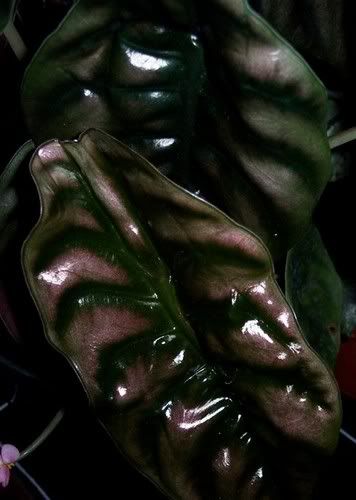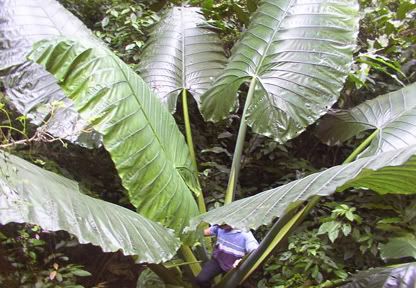Alocacias

This is a little dark, but I don't have a better shot at the moment. Alocasia cuprea has an odd juvenile leaf that looks heavily shellacked. I've never read about any speculation on what the purpose of that would be. I can't imagine one, unless it's to help prevent fungus. It's a small plant, growing only about 50 cm tall, with leaf blades about 30 cm long.
Alocasias belong to the family Araceae, one of the largest plant families, which includes philodendrons, anthuriums, colocasias, amorphophallus, xanthosomas, and many other genera.

Contrasting with species like A. cuprea, which grow close to the rainforest floor, are alocasias with the largest leaves of any herbaceous plants in Nature, such as Alocasia robusta, whose leaves can reach 10 meters in height. Click here for a truly awesome photo of Alocasia robusta, growing in the wild in Sarawak.

4 Comments:
I'd stared at the Alocasia robusta for quite a while before I saw the figure underneath the damn thing, which showed the scale. It is truly enormous!
The small one is beautiful, the lovely colour enhanced by the highly glossed surface.
I should have noted that the spot of color isn't an inflorescence. :) The robusta in the link is probably even larger than that one is, although there's no human to compare the size to. It's difficult to grow them to any size without the constant humidity.
There are many men who like to collect and grow aroids. There's a certain air of masculinity to Araceae. I haven't figured out why that is.
Inflorescence - that sent me for the dictionary. As to why men grow aroids....... I wouldn't dare comment.
Going to the opposite extreme ( and partly through your influence) I have plucked up courage to take on a project this summer photographing the many types of rare wild orchids which grow on the mountains and moors in this part of Scotland. ( I may be wrong, but I seem to remember you saying you weren't too keen on orchids)
These are tiny things, the blooms being no more than half an inch across and, apart from shooting them on large format with film, not digital, in extreme close-up, which is a nightmare, the identification process will be... indescribably difficult.
But I can't wait.
I love to look at orchids; I just don't enjoy growing them. Your project sounds great. I know the orchid fanatics would be fascinated. I didn't even realize that non-tropical orchids existed! If you shoot enough, you could do a book.
Post a Comment
<< Home